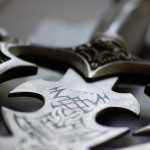Created by: paul01234
Number of Blossarys: 51
A sword with a grip for two handed use but not heavy enough to prevent one handed use. Used during the 13th to the 17th centuries, with the most use during the late medieval and early Renaissance.
Roman sword, mass produced. A one handed sword with an unobstructive guard useful for cutting and chopping as well as thrusting and piercing. A very practical sword that managed to conquer for the ...
A longsword designed for use against mail or plate armor. The shape and length of the sword made it useful for thrusting and for keeping out of range of enemy swords.
A true double handed sword (the name literally means "two-hander") that requires both hands to use the sword. It slowly became more of a polearm than a sword due to its length.
A sword of German origin used during the Renaissance. A one-handed shortsword with a figure eight guard to protect the user's hand should the opponent's blade go down to the hilt.
A thin sword designed for thrusting attacks, with a very ornate, elegant, and complex hilt to prevent damage to the wielder's hand. It can cut but the thinness of the blade made it more practical to ...
A curved sword designed for cutting. The saber has a guard extending all the way down the hilt to protect the hand from injury. Not closely related to the use of the saber in fencing.


 English (EN)
English (EN)